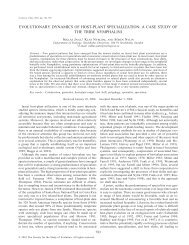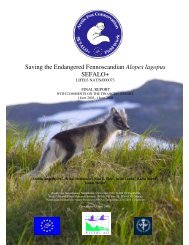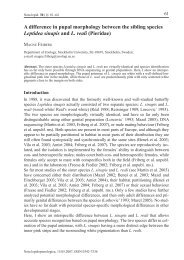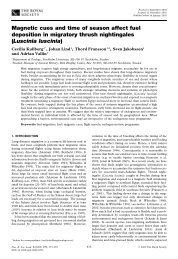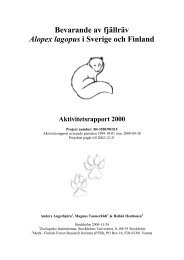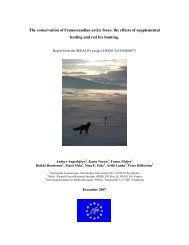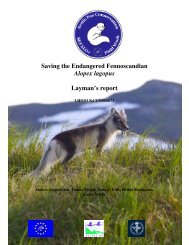Elmhagen et al. 1281Fig. 2. Frequencies of occurrence of different prey species at<strong>arctic</strong> <strong>and</strong> <strong>red</strong> fox dens at different altitudes. Solid symbols denotedens inhabited by <strong>arctic</strong> <strong>foxes</strong> <strong>and</strong> open symbols denotedens inhabited by <strong>red</strong> <strong>foxes</strong>. For the two species <strong>and</strong> all yearscombined, there was a tendency towards a positive correlation<strong>between</strong> altitude <strong>and</strong> occurrence of lemmings (a), but there weresignificant negative correlations <strong>between</strong> altitude <strong>and</strong> occurrenceof field voles (b) <strong>and</strong> birds (c).100806040200100806040200100806040200(a)199319961997800 850 900 950 1000 1050 1100(b)199319961997800 850 900 950 1000 1050 1100(c)199319961997800 850 900 950 1000 1050 1100<strong>overlap</strong> <strong>between</strong> summers was 60.8% for <strong>arctic</strong> <strong>foxes</strong> <strong>and</strong>58.5% for <strong>red</strong> <strong>foxes</strong> (Table 4). Using Horn’s index, the averagefor <strong>arctic</strong> <strong>foxes</strong> was 0.79 (range 0.68–0.98). The averagefor <strong>red</strong> <strong>foxes</strong> was also 0.79 (range 0.68–0.93). Nevertheless,food-<strong>niche</strong> <strong>overlap</strong> <strong>between</strong> <strong>arctic</strong> <strong>and</strong> <strong>red</strong> <strong>foxes</strong> was consistentlyhigh in three out of four summers (percent <strong>overlap</strong>75.1–79.6%; Horn’s index 0.92–0.93), with a smaller <strong>overlap</strong>in 1997 (44.2% <strong>and</strong> 0.63, respectively; Fig. 1, Tables 2<strong>and</strong> 4). In 1997, however, food-<strong>niche</strong> <strong>overlap</strong> was smallerwithin <strong>red</strong> <strong>foxes</strong> than <strong>between</strong> <strong>arctic</strong> <strong>and</strong> <strong>red</strong> <strong>foxes</strong>. The<strong>overlap</strong> within <strong>arctic</strong> <strong>foxes</strong> seemed to be higher than <strong>between</strong>species when the lemming population was in the increase<strong>and</strong> crash phases, while <strong>overlap</strong>s within <strong>and</strong> <strong>between</strong>species were similar during the lemming low phase in 1998(Table 4).Arctic <strong>foxes</strong> had narrower food-<strong>niche</strong> breadths than <strong>red</strong><strong>foxes</strong> during the lemming increase <strong>and</strong> crash phases (1996–1997), while both fox species were relatively generalisticwhen the lemming population was in the low phase (1993,1998; Fig. 1, Table 2).Effect of altitudeWe found small-scale spatial segregation <strong>between</strong> the foxspecies. Dens inhabited by <strong>arctic</strong> <strong>foxes</strong> were situated at higheraltitudes than those inhabited by <strong>red</strong> <strong>foxes</strong> (logistic regression,p < 0.001, χ 2 = 18.7, df = 1, n = 24). Dens used exclusivelyby <strong>red</strong> <strong>foxes</strong> were found <strong>between</strong> 800 <strong>and</strong> 900 m asl,while those used solely by <strong>arctic</strong> <strong>foxes</strong> were found at 880–1100 m asl. Two dens situated at 900 <strong>and</strong> 920 m asl wereused alternately by both fox species. However, <strong>red</strong> <strong>foxes</strong>were never found at higher altitudes than <strong>arctic</strong> <strong>foxes</strong> duringthe same summer (Fig. 2).For <strong>arctic</strong> <strong>and</strong> <strong>red</strong> <strong>foxes</strong> combined, there were significantnegative relationships <strong>between</strong> altitude <strong>and</strong> the occurrence offield voles (p = 0.013, r S = –0.50, Fig. 2b) <strong>and</strong> birds (p =0.024, r S = –0.57; Fig. 2c) in the diets. There was also a tendencytowards a positive relationship <strong>between</strong> the occurrenceof lemmings <strong>and</strong> altitude (p = 0.057, r S = 0.39; Fig. 2a).None of the relationships were significant if the fox specieswere treated separately. There was no relationship <strong>between</strong>the occurrence of reindeer in the diets <strong>and</strong> altitude (p = 0.41,r S = 0.18).DiscussionLemmings, field voles, birds, <strong>and</strong> reindeer were the essentialprey species for both <strong>arctic</strong> <strong>and</strong> <strong>red</strong> <strong>foxes</strong> in the VindelfjällenNature Reserve. However, lemmings occur<strong>red</strong> more frequentlyin <strong>arctic</strong> fox scats than in <strong>red</strong> fox scats, while field voles <strong>and</strong>birds occur<strong>red</strong> more often in <strong>red</strong> fox scats than in <strong>arctic</strong> foxscats. Reindeer occur<strong>red</strong> equally often in the scats of bothfox species. Other prey items, i.e., Clethrionomys spp., shrews,mountain hare, eggs, <strong>and</strong> insects, occur<strong>red</strong> infrequently <strong>and</strong>were probably of little importance to either fox species. Shrewsoccur<strong>red</strong> only in the scats of <strong>arctic</strong> <strong>foxes</strong>, but both <strong>arctic</strong> <strong>and</strong><strong>red</strong> <strong>foxes</strong> generally dislike <strong>and</strong> avoid eating shrews (Lockie1959; Chesemore 1968; Barth et al. 2000). Hares occur<strong>red</strong>only in the scats of <strong>red</strong> <strong>foxes</strong>, but other studies have shownthat <strong>arctic</strong> <strong>foxes</strong> sometimes include hares in their diet(Macpherson 1969; Birks <strong>and</strong> Penford 1990; Str<strong>and</strong> et al.1999; Frafjord 2000). Thus, the absence of shrews in <strong>red</strong> foxscats <strong>and</strong> hares in <strong>arctic</strong> fox scats may not be related to foxspecies, but to r<strong>and</strong>om occurrences of rare prey.© 2002 NRC Canada
1282 Can. J. Zool. Vol. 80, 2002Table 4. Percent <strong>overlap</strong>s <strong>between</strong> <strong>and</strong> within fox species in different summers.Within speciesYearLemmingphase Between species Arctic fox Red fox1993 Low 79.6 — —1996 Increase 79.6 91.9 (83–100) —1997 Crash 44.2 90.6 (88–94) 28.71998 Low 75.1 79.3 (71–85) 75.9 (54–92)Between summers 54.7 (28.8–84.2) 60.8 (46–97) 58.5 (45–83)Note: For years when there were scats from more than one den, food-<strong>niche</strong> <strong>overlap</strong>s within speciesare shown as the average from pairwise calculations of <strong>overlap</strong> <strong>between</strong> the dens. The last row showsthe average of pairwise calculations of <strong>overlap</strong> <strong>between</strong> summers. Numbers in parentheses are ranges.There was spatial segregation <strong>between</strong> the fox specieswith respect to altitude. Our dataset is therefore representativeof what appears to be the general pattern on the mountaintundra in Fennosc<strong>and</strong>ia: <strong>arctic</strong> <strong>foxes</strong> use dens at relativelyhigh altitudes, while <strong>red</strong> <strong>foxes</strong> occupy dens at lower altitudes(Østbye et al. 1978; Linnell et al. 1999; Dalerum et al. 2002).For the two species combined, consumption of field voles<strong>and</strong> birds decreased with increasing altitude, while consumptionof lemmings increased with altitude. These results areconsistent with those of Frafjord (2000). Field voles preferproductive tundra habitats <strong>and</strong> are generally more abundantat lower altitudes, while lemmings are more common in unproductivehabitats <strong>and</strong> at relatively higher altitudes (Oksanen<strong>and</strong> Oksanen 1992; Oksanen et al. 1999). Birds are far lessabundant in unproductive than in productive tundra habitat(Svensson et al. 1984). Productivity generally decreases withincreasing altitude, so the observed relationships probablyreflect changes in prey abundance.Two dens were used alternately by <strong>arctic</strong> <strong>and</strong> <strong>red</strong> <strong>foxes</strong>.Although a small number of individuals were involved, theirdiets are interesting, since the species hunted in approximatelythe same territories, i.e., at the same altitude. Thefirst den, at 900 m asl, was inhabited by <strong>arctic</strong> <strong>foxes</strong> duringthe year of the lemming increase phase (1996) <strong>and</strong> by <strong>red</strong><strong>foxes</strong> during a lemming low phase (1998). Lemmings occur<strong>red</strong>more often in <strong>arctic</strong> fox scats than in <strong>red</strong> fox scats,while the reverse was true for field voles <strong>and</strong> birds (Fig. 2).The second den, at 920 m asl, was inhabited by <strong>arctic</strong> <strong>foxes</strong>in 1996–1998 <strong>and</strong> by <strong>red</strong> <strong>foxes</strong> during the lemming lowphase in 1993. Lemmings occur<strong>red</strong> frequently in <strong>arctic</strong> foxscats during the lemming increase- <strong>and</strong> crash-phase years(1996–1997), while occurrences of lemmings dropped markedlyduring the low-phase years, 1998 <strong>and</strong> 1993, when theden was inhabited by <strong>arctic</strong> <strong>and</strong> <strong>red</strong> <strong>foxes</strong>, respectively. Fieldvoles rarely occur<strong>red</strong> in the scats of either species, exceptfor 1998, when there was a marked increase in the occurrenceof field voles in <strong>arctic</strong> fox scats (Fig. 2).For each year, occurrences of different prey in scats atthese dens were similar to those that would be expectedbased on the general patterns of diet composition <strong>and</strong> preyavailability in these years. This indicates that interspecificdifferences in diet can be p<strong>red</strong>icted on the basis of preyavailability only, <strong>and</strong> do not require differences in prey preferenceto explain them.Since <strong>arctic</strong> <strong>and</strong> <strong>red</strong> <strong>foxes</strong> were spatially segregated, neitherscenario 1 nor 2, described in the Introduction, explainsthe differences <strong>between</strong> <strong>arctic</strong> <strong>and</strong> <strong>red</strong> fox diets. However,we found significant temporal differences in <strong>foxes</strong>’ diets <strong>and</strong>this variation was reflected in relatively low average food<strong>niche</strong><strong>overlap</strong> <strong>between</strong> years within each species (60.8 <strong>and</strong>58.5% for <strong>arctic</strong> <strong>and</strong> <strong>red</strong> <strong>foxes</strong>, respectively). Despite this,food-<strong>niche</strong> <strong>overlap</strong> <strong>between</strong> the species was consistently highin 3 out of 4 years (75.1–79.6%). During the lemming increasephase, <strong>arctic</strong> <strong>and</strong> <strong>red</strong> <strong>foxes</strong> mainly consumed lemmings.During lemming low phases, food-<strong>niche</strong> <strong>overlap</strong> remainedhigh, owing to increased consumption of the same alternativeprey: reindeer, voles, <strong>and</strong> birds in 1993 <strong>and</strong> voles <strong>and</strong>birds in 1998. In one year, 1997, <strong>foxes</strong> deviated from thispattern, but the variation within <strong>red</strong> <strong>foxes</strong> was larger thanthe variation <strong>between</strong> the species. This may indicate that denwas a more important factor for diet than species. Eitherway, the dominant pattern was that <strong>arctic</strong> <strong>and</strong> <strong>red</strong> <strong>foxes</strong> respondedsimilarly to changes in prey availability, <strong>and</strong> <strong>niche</strong><strong>overlap</strong> was relatively constant <strong>between</strong> years, which supportsscenario 3. Thus, <strong>arctic</strong> <strong>and</strong> <strong>red</strong> <strong>foxes</strong> have similarprey preferences, while the spatial segregation <strong>between</strong> themcould have caused the observed differences in diets.Our samples were larger than that in two earlier comparisonsof <strong>arctic</strong> <strong>and</strong> <strong>red</strong> fox diets (Smits et al. 1989; Frafjord1995), but were still small in some years. There are severalreasons why samples were small despite our large studyarea. The <strong>arctic</strong> fox in Sweden is threatened with extinction.Further, since <strong>arctic</strong> <strong>foxes</strong>’ reproduction depends heavily onlemming availability (Str<strong>and</strong> et al. 1999; Elmhagen et al.2000), only a few dens were inhabited in years when lemmingdensity was low. On the other h<strong>and</strong>, the number ofdens inhabited by <strong>red</strong> <strong>foxes</strong> on the mountain tundra is independentof lemming phase but positively correlated withvole availability in surrounding forests (unpublished data).This is also reflected in our sample sizes. The numerical responsesof <strong>arctic</strong> <strong>and</strong> <strong>red</strong> <strong>foxes</strong> to lemming <strong>and</strong> vole availabilityled to skewed samples <strong>between</strong> both years <strong>and</strong> foxspecies. However, since <strong>arctic</strong> <strong>and</strong> <strong>red</strong> fox diets are affectedby temporal variation in lemming <strong>and</strong> vole availability, thetemporal aspect should be included in comparisons of theirdiets. Frafjord’s (2000) study on <strong>arctic</strong> <strong>and</strong> <strong>red</strong> fox diets inFennosc<strong>and</strong>ia over 5 years involved a large sample but wasskewed <strong>between</strong> years <strong>and</strong> fox species. He did not considervariation in prey availability. He concluded that environmentalfactors explained most of the differences <strong>between</strong> <strong>red</strong> <strong>and</strong><strong>arctic</strong> fox diets in Fennosc<strong>and</strong>ia, but suggested that <strong>arctic</strong><strong>foxes</strong> depended more on lemmings than <strong>red</strong> <strong>foxes</strong> at thesame altitude did. Thus, he suggested that <strong>arctic</strong> <strong>and</strong> <strong>red</strong><strong>foxes</strong> would use similar prey bases differently. Although our© 2002 NRC Canada



